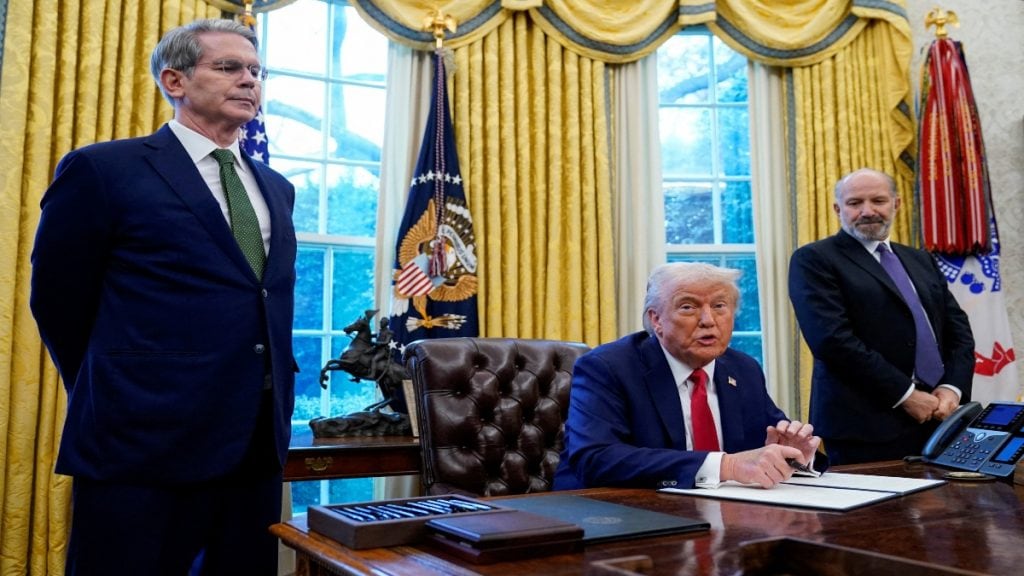US President Donald Trump has repeatedly gloated about it on social media and interviews.
“We have a lot of money coming in, much
But where is the money going?
Let’s take a closer look:
How much is coming in?
First let’s briefly examine how much money is coming in to US revenues.
Trump has claimed that billions of dollars are flowing into the US every day. That isn’t true. The US till the end of July had taken in nearly $130 billion in tariffs.
Tariffs have been steadily growing throughout the year with January seeing $8 billion coming in, April witnessing another $16 billion, and
The $28 billion figure is a massive 240 per cent increase over the same month last year.
In 2024, the US took in around $79 billion from tariffs for the entire year.
Scott Besson has claimed that the US government could take in as much as $300 billion from tariffs this year.
What has Trump promised to do?
Trump has promised to spend the money on either paying down the debt or sending rebate checks to Americans.
“The purpose of what I’m doing is primarily to
“The big thing we want to do is pay down debt, but we’re thinking about a rebate,” Trump previously said. “We have so much money coming in from tariffs that a little rebate for people of a certain income level might be really nice.”
Neither has happened thus far.
So,

US Secretary of the Treasury Scott Bessent and Howard Lutnick stand as US President Donald Trump speaks. Reuters
While the tariffs could theoretically go towards paying down the national debt,this is easier said than done. This is because the US runs at a massive budget deficit. Meaning it spends far more
The US this year alone has a fiscal deficit of $1.3 trillion. Meanwhile, the national debt is at around $36 trillion. How does it finance its spending? By taking massive loans, of course.
Which means all the tariff money that is coming in is currently going to service the fiscal debt. Meaning there isn’t anything extra left over to pay down the national debt or even issue rebate checks.
But that hasn’t stopped some from floating the idea of doing so anyway.
Republican
However experts are against it.
Ernie Tedeschi, director of economics at the Budget Lab at Yale and a former economist in the Biden White House told cnn such a move would causeway the deficit to widen.
“They’re the wrong policy to pursue right now,” he added, warning inflation could spike.
The US Federal Reserve is aiming to keep inflation at two per cent.
However, inflation was at 2.7 per cent in January, 2.4 per cent in May and 3 per cent
Tariffs are hurting economy
Here, it is important to note that tariffs aren’t paid by other countries.
Instead it is businesses who foot the bill for tariffs – and invariably pass them onto the consumer.
Evidence is piling up the tariffs are already hurting the US economy.
Already a number of companies that make appliances, toys, and consumer electronics are increasing prices for consumers. Others are warning that price increases are in the offing if the tariffs remain.
Meanwhile, the US

Evidence is piling up the tariffs are already hurting the US economy. Reuters
Trump responded to the bad numbers by firing Erika McEntarfer,commissioner of the Bureau of Labor Statistics (BLS). The US president claimed
What do experts say?
Experts predict the worst is yet to come.
“Tariffs are going to have a negative economic effect on the American economy,” Tedeschi told CNN. The Yale Budget Lab said tariffs will cause US GDP to shrink .50 per cent this year and another half a point next year.
“That’s going to partly but not fully offset the amount of revenues that we raise from tariffs. Because if your economy is
Worse, the CBO, an independent and non-partisan US government agency, has predicted that Trump’s tax cuts and other policies are set to explode the fiscal deficit and the national debt by trillions by the time he leaves office.
Trump even mused about replacing the income tax with tariffs. For those unaware, America generated $2.4 trillion via income tax last
Regardless, the White House is insistent that Trump is ushering in the golden age of America.
US consumers are about to find out whether or not that’s true in the near future.
With inputs from agencies















